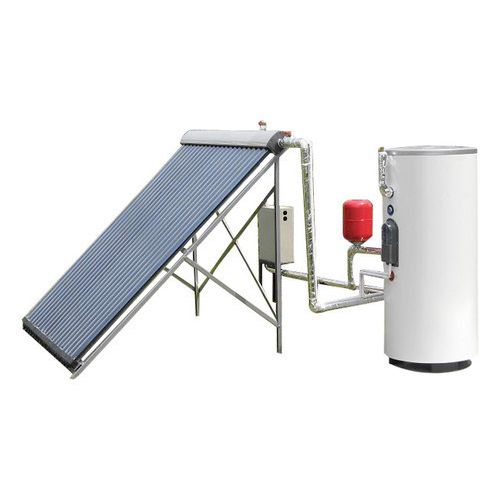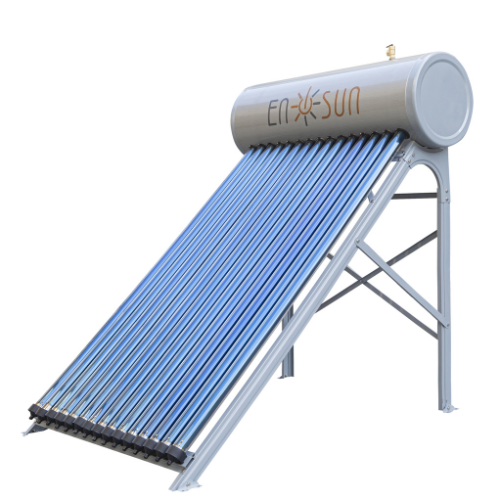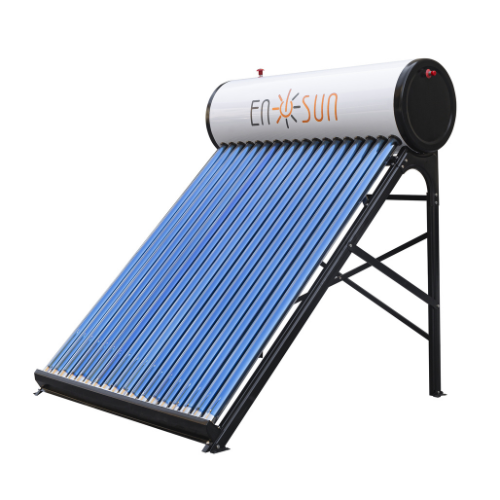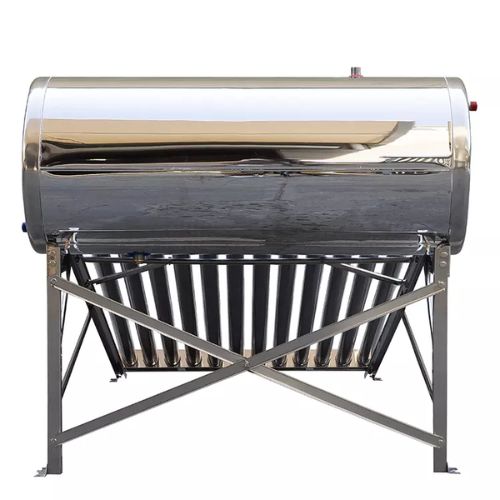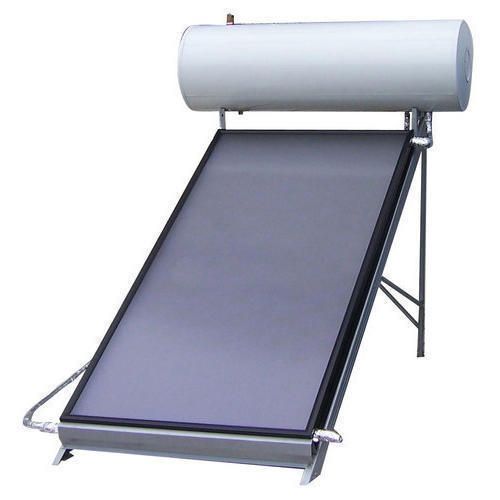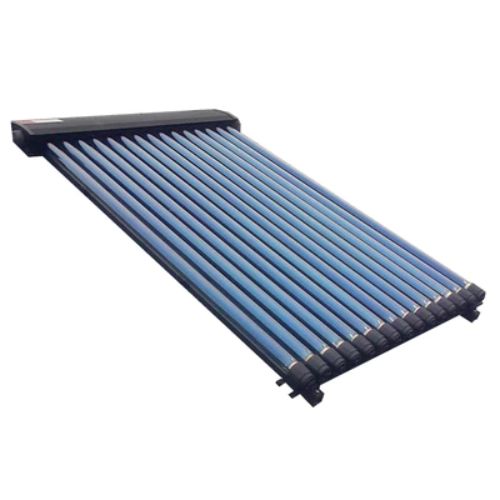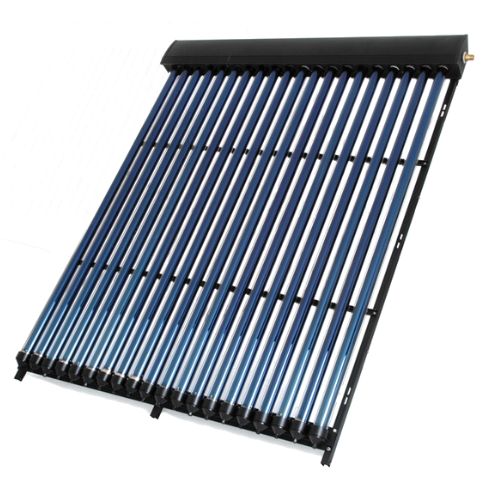Solar Water Heater
Solar water heaters are an affordable method of producing hot water for a house, business, industry, hotel, or other location. They are adaptable to every climate. Solar water heaters don’t heat water using grid energy. Instead, these energy-efficient appliances employ specialized rooftop solar collectors to capture energy from the sun.
Ensun solar water heaters are extremely popular. They lower electricity costs and enable using sustainable energy to heat water. Available as a direct or indirect system, an active or passive setup. We design all types of the latest solar water heaters. All products undergo strict quality control and are packed at a high-quality level. Fast production lead time, low MOQ, and cost-effectiveness. We also support OEM production to boom your brand. Message us today!
Split solar water heaters provide maximum flexibility of installation. On the roof are solar collectors fixed. The storage tank is concealed and installed at ground level.
Utilized pressurized water tanks that provide reliable water pressure. It features heat pipes and evacuated tubes, 150Liter water capacity in the water tank, etc. Energy saving device.
Compact non-pressure solar water heater has low noise operation, is fully automatic and static. No pollution and no leakage for longer use. Environmentally friendly, safe, and reliable.
Supply instant hot water, no water scale, high efficiency. Designed especially for pre-heating, suitable for low-pressure thermal stores.
Flat plate solar water heater catches solar energy and uses it to heat water for washing, bathing, and heating. Also used to heat outdoor hot tubs and swimming pools.
Why Choose Ensun Solar Water Heater
- Certified Products – Our products are compliant to various certifications such as ISO, IEC for electrical heaters, Solar Keymark EN12975, Solar Keymark EN12976, CE, etc.
- Quality Product Assurance – Solar water heaters have a 5 years quality warranty.
- Durable Materials – We use top-quality and brand-new materials. Cost-effective with a quick return on investment.
- Strict quality control – During production, we provide production reports, water tank leaking inspections, and package confirmation.

Related Product
Solar Water Heater: A Complete Guide for Beginners & Experts
Before you buy a solar water heater (SWH), it is important to know the working principle, parts, and technology involved, among other vital aspects.
Once you have the right information, choosing the right SWH will be a simple process – let’s dive right in.
What is a Solar Hot Water Heater?
A solar water heater is a system that warms or heats water to a suitable temperature. It uses solar energy for the entire heating process.
These water heating systems come in different configurations, as you will discover shortly in this guide.
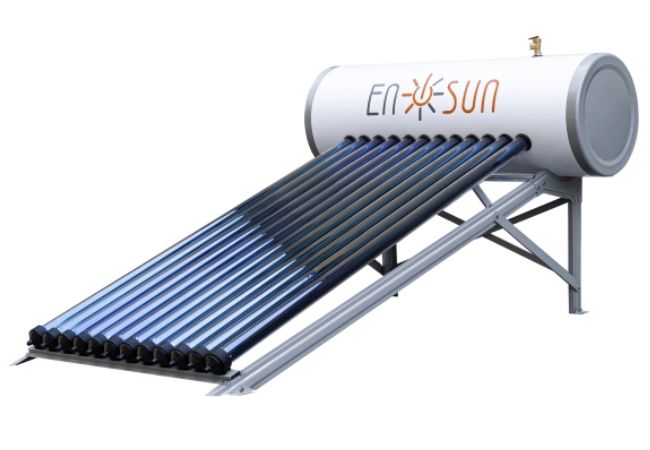
SWH
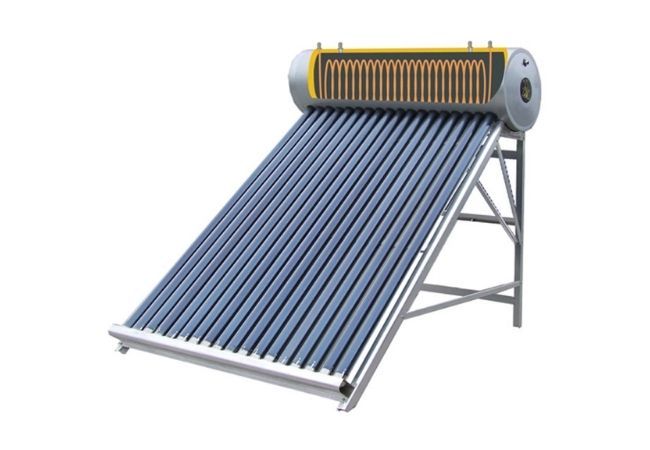
Inside Solar Water Heater Tank
How to find your trusted solar heater supplier?
You can always trust Kesun solar which is one of the biggest solar heater supplier in China. Kesun solar is dedicated to supply you highest quality products with competitive price by increasing the production technology. In Kesun Solar, every connections are welded by argon protected welding. Argon protected welding can effectively avoid of oxidation reaction during high temperature of welding. So you can rarely found rusted leakage on connections from Kesun solar heater.
Some other solar heater suppliers are still using normal welding or even rubber sealing on connections of solar heater. When the water leak out from the connections, they even not understand why it will happen.
So after you read this, you will know who is your trusted solar heater supplier.
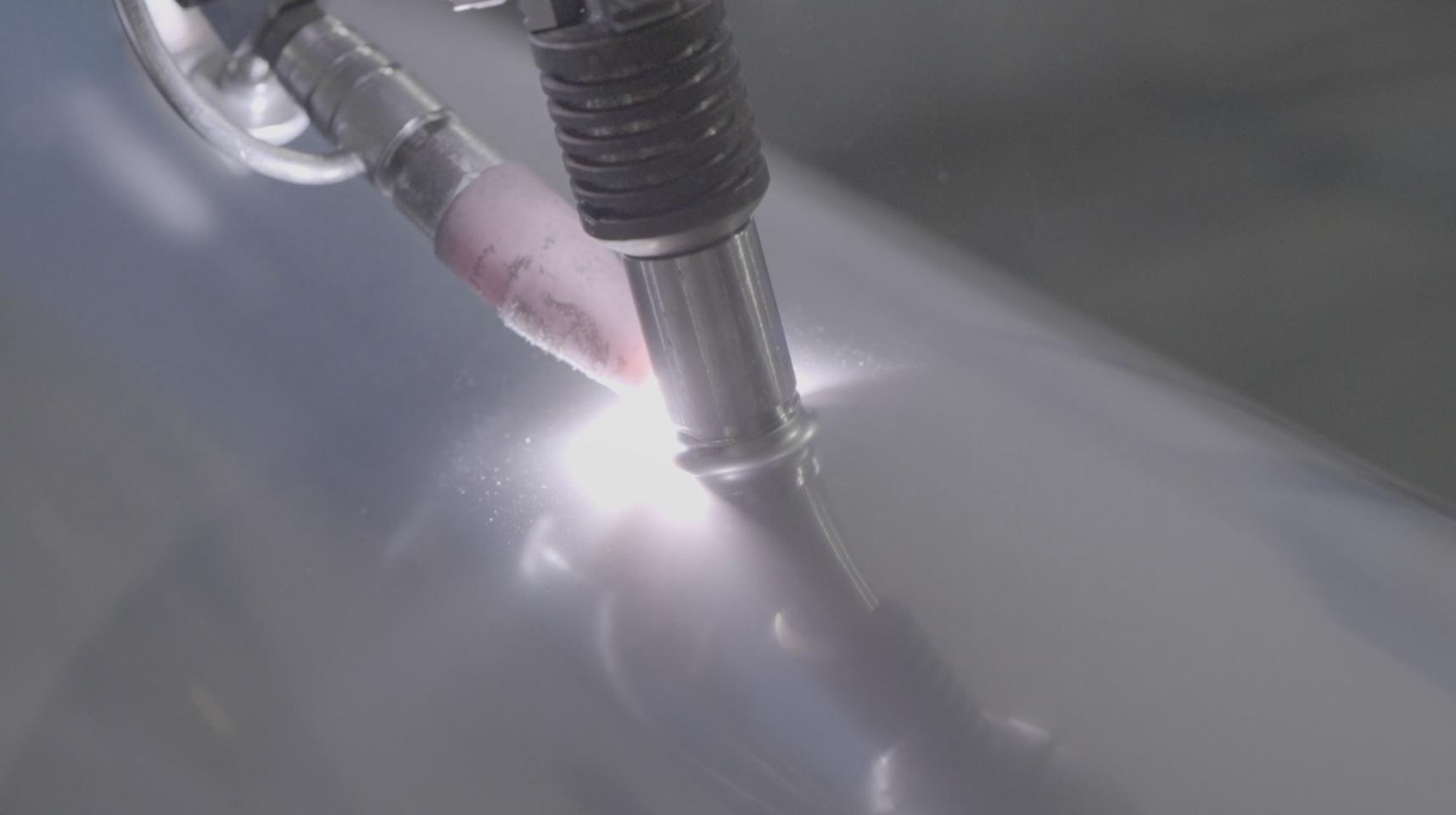
Solar-Powered Water Heater Benefits
- Cost-effective solution for heating water – once you install the heating system, you will not incur additional energy costs since the system depends on the sun’s energy.
- Low maintenance – most solar waters will save you the maintenance costs
- Fuel savings – it is a perfect replacement for the electrical geyser or other eating technologies that use fuel.
- Eco-friendly – they do not produce any emissions. Solar energy is clean and sustainable
- Short pay-back period – although the initial investment can be high, the payback period be 2 to 4 years.
- It reduces carbon footprint
- The initial installation cost can be low, especially where the local authorities offer incentives for adopting sustainable water heating solutions.
Parts of Solar Water Heating Systems
Storage Tanks
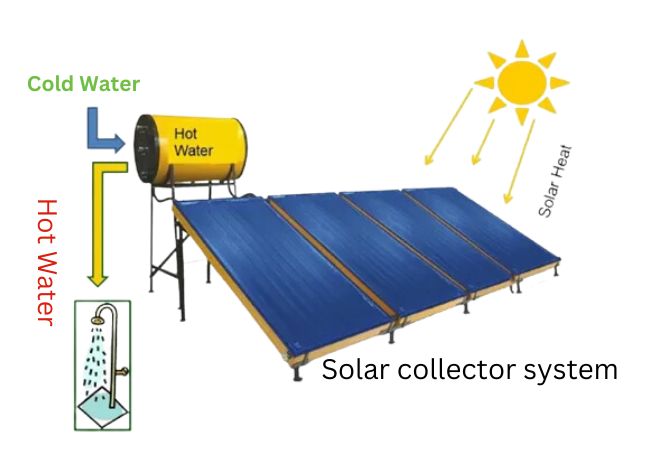
Solar Thermal Water Heater
Whenever you are considering tanks for solar panel water heaters, it is important to note:
- 1-tank system: some have unique designs with an option for a backup heating system
- 2-tank system: water is preheated before the normal heating takes place. Today, you will find many pre-heated solar thermal heating systems in the market.
At times, a thermosyphon system is necessary. Ideally, this system helps in energy management, making it a perfect backup plan in solar water heating systems.
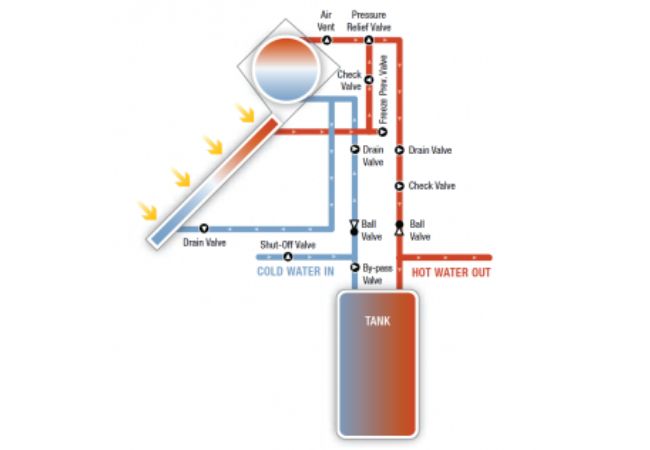
Thermosyphon Systems for Solar Panels Water Heater
In most cases, these storage tanks are made from welded steel with an internal heat exchanger system. At the same time, they may have heating elements as a backup. This will ensure the tank retains its temperature even when there is no sufficient sunlight.
Among the key factors you should consider when choosing a solar hot water heater storage tank include:
- Double wall with proper insulation
- The inner section of the tank should be stainless steel or rust-resistant metals
- The outer section can be made from stainless steel, aluminum, or other material. If possible, it should be painted to prevent corrosion
- Heating element is an option but they should have a thermostat to help regulate the temperature
- Tank capacity – it varies depending on where you plan to use the water tank. For instance, bathing may require about 10 to 15 liters, while shaving will require 7 to 10 liters.
Remember, there are the solar tankless water heaters. Usually, these systems only heat water when you need it. Additionally, these systems require small installation space.
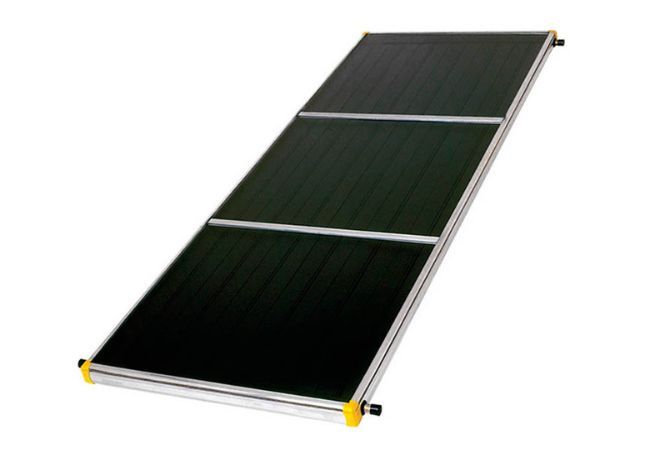
Tankless SWH
However, the solar tankless water heater may not supply many users simultaneously. Besides, integrating this system in the existing building with solar powered water heaters can be cumbersome.
Insulation Material
The insulation will prevent possible heat loss. Although there are many options to control heat loss, the most popular insulation material is thick polyurethane.
Solar Thermal Panel

Thermal vs PV Solar Panel
Most people tend to confuse PV solar panel technology and solar thermal. Ideally, these are two different technologies.
Solar photovoltaics produce electrical energy. On the other hand, solar thermal technology is specifically designed to produce heat. The heat can be stored and transformed into electrical energy.
In most cases, solar thermal work hand in hand with the solar collector systems.
With the help of a solar collector, the system automatically traps, transforms, and transfers the energy to the fluid transfer system.
Generally, there are 3 main collectors for water heating systems:
| Flat Plate Collector | Integral Collector Storage (ICS) | Evacuated Tube Collector |
|
|
|
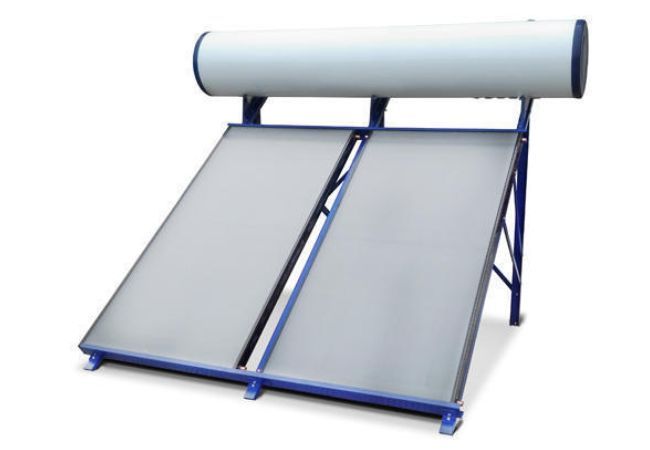
Flat Plate Water Heaters
Additionally, there is the compound parabolic collector for solar hot water heating systems. They feature a reflective geometry for optimal concentration of solar energy for heating water.
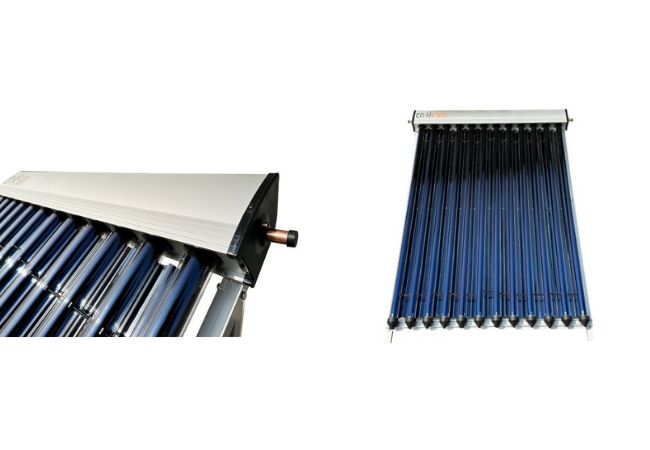
Compound Parabolic Collector
In most cases, the thermal solar collector for water heating is arranged in a combination of parallel and series. Ideally, this maximizes the amount of energy it can get from the sun hence an efficient heating process.
Piping System
They are conduits that transport heating fluid and water throughout the system.
Electric Element
An electric heating element that heats rapidly guarantees significant cost savings. It helps to generate heat energy.
Temperature Sensor
Most water heating systems are equipped with thermostats. It helps to control the temperature within the tank thereby preventing possible overheating.
Heat Transfer Fluid
The fluid provides a medium for heat energy transmission from the thermal solar water heater collector to the heat exchanger system. Many factors determine the efficiency of heat transfer fluid such as:
- Coefficient of expansion
- Viscosity
- Thermal capacity
- Safety
- Boiling and freezing point
- Compatibility with the system i.e. it should be non-corrosive
Let’s explore some common fluids for these systems:
| Type of Heat Transfer Fluid | Main Characteristics |
| A mixture of water and propylene glycol |
|
| Water |
|
| Air |
|
Heat exchanger
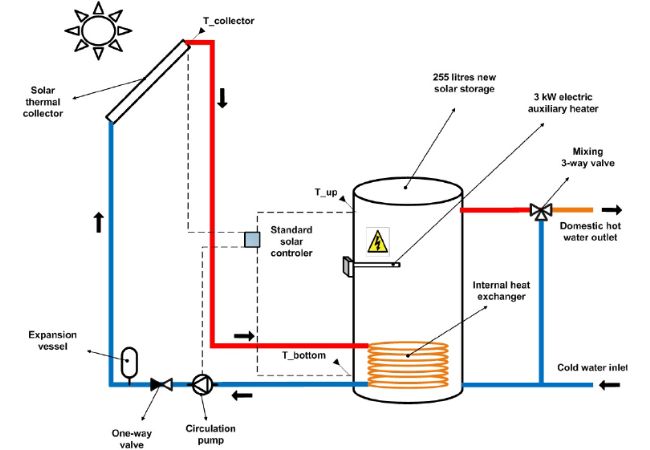
Heat Exchanger for Thermal Water Heater
The heat transfer fluid and water do not mix. The heat exchanger allows for heat transfer from fluid to water. A larger surface area will guarantee an efficient and reliable heat transfer process.
However, most thermal water heating systems heat exchangers are made from copper due to superior thermal conduction properties. Stainless steel is also an option.
In most heat exchangers, the heat transfer takes place between liquid to liquid. The heat transfer fluid is mainly propylene glycol mixed with water.
Of course, there are SHWs with air-to-liquid heat transfer systems. In such situations, there is no heat transfer fluid.
Additionally, you can opt for coil-in-tank, shell-and-tube, or tube-in-tube systems.
Pump
They are common in active solar heating systems. They help circulate water throughout the systems. Other related components include water heating system valves, pumps, etc.
At the same time, you can use the pumps in the heat transfer fluid circulation.
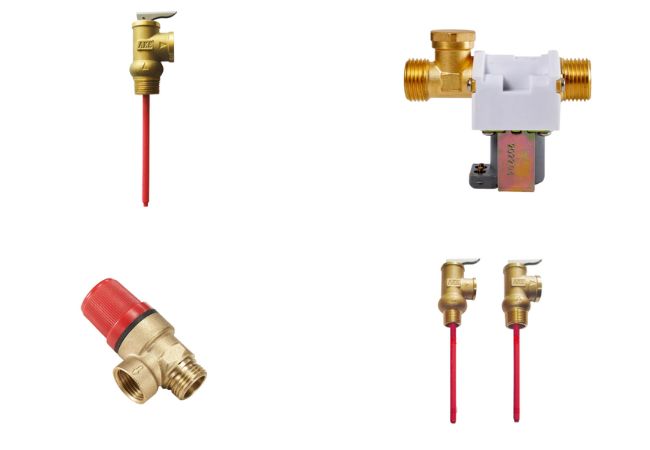
Water Heating System Valve
Control System
These are electronic devices helping to control various systems in the solar thermal water heating system. Additionally, they also ensure the overall safety of the system.
Working Principle of Solar Powered Water Heater
The thermal water heater working principle may vary slightly depending on the design and configuration. However, the fundamental principle is mainly:
- Thermal collectors convert radiation from the sun into heat energy
- With the help of special heat transfer fluid, it “passes” the heat to water
- Thermal regulators help in the heat exchange process
- As the water heats up, its density reduces hence moving to the top of the tank ready for use. At the same time, cold water with high-density move at the bottom of the tank for heating.
Although the fundamental working principle of solar hot water heaters remains the same, there could be some variations. Usually, this depends on the SWH system design.
Active Solar Water Heater
Let’s compare the two:
| Indirect Circulation | Direct Circulation |
|
|
Let’s discuss these two systems in detail:
Direct Circulation
Usually, this system is also called the open-loop system. Normally, you can use these systems in areas that:
- Experience less freezing – it is a perfect system for moderate to mild climates
- Have single application requirements such as domestic hot water systems
That is, water flows to other parts of the building from the solar collector system with the help of a pump.
At times, we also refer to these water heaters as Drainback systems.
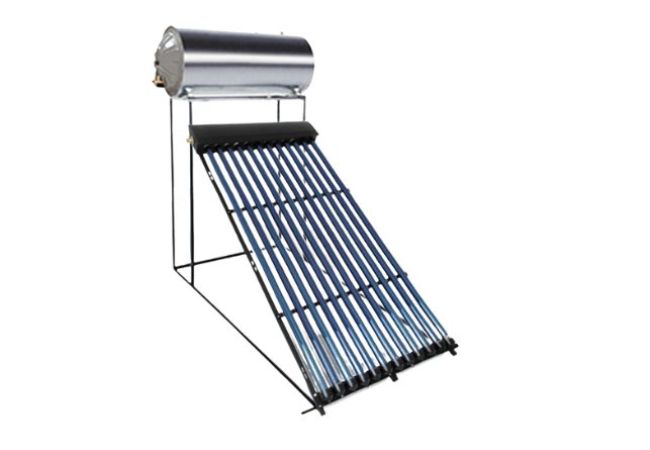
Direct Circulation System
However, in case you wish to install the open loop water heating in areas that are susceptible to mild freezing, then go for recirculation systems.
The recirculation systems use heating pipes whenever they approach freezing temperatures. That is, the water flows from the tanks, through the collector, and to the piping system.
Remember, when you activate anti-freezing protection in the recirculation systems, you will incur additional energy costs. It is because you will use electricity.
However, in case there is a power outage, you must install a freeze valve.
Advantages of Open Loop System
- Easy to integrate with an existing system
- Simple design makes it the most affordable
- Ensures efficient heat transfer
- Expanding the water heating system is easier
Limitations of Open Loop System
- Anti-freezing system increases the operational costs
- Not suitable for areas that are prone to freezing
Indirect Circulation System
If you are looking for a water heating system suitable for regions known for freezing then choose indirect circulation water heating systems. Owing to their unique designs, you can refer to these systems as closed-loop active solar hot water heaters.
The closed loop is suitable for multiple applications. For instance, using a single water heating system, you can use the system for:
- Swimming pool water heating
- Hot tub water heating
- Shower water heating, etc.
These systems have anti-freeze fluid that prevents possible freeing. The pumping system ensures a consistent flow of:
- Ant-freezing fluid
- Heat transfer fluid
The mixture of heat transfer fluid and anti-freeze liquid flows through the collector, and to the heat exchanger system. Currently, closed-loop glycol water heaters are effective when it comes to freezing protection. To maintain this efficiency, you must change the glycol after 3 years, depending on the quality.
Advantages of Closed Loop Systems
- A perfect choice for areas prone to freezing
- Allowing for easy integration with multiple systems
Limitations of Closed Loop Systems
- Compared to open loop systems, they are more complicated
- Changing the anti-freeze adds additional maintenance cost
Passive Solar Water Heater
There are two options:
| Integral Collector Storage Systems | Thermosyphon system |
· Water heating takes place in the storage tank |
|
Due to their simple construction, these water heating systems remain simple and affordable. Broadly, you will find integral collector storage and convection heat storage.
Apart from these, there are other common terms describing these SWH systems:
- Pressurized solar water heater
- Non-pressurized solar water heating systems.
Of course, this classification mainly depends on the solar thermal water heater working principle.
Let’s compare the two:
| Pressurized Solar Water Heater Panels | Non-pressurized Solar Water Heating System |
|
|
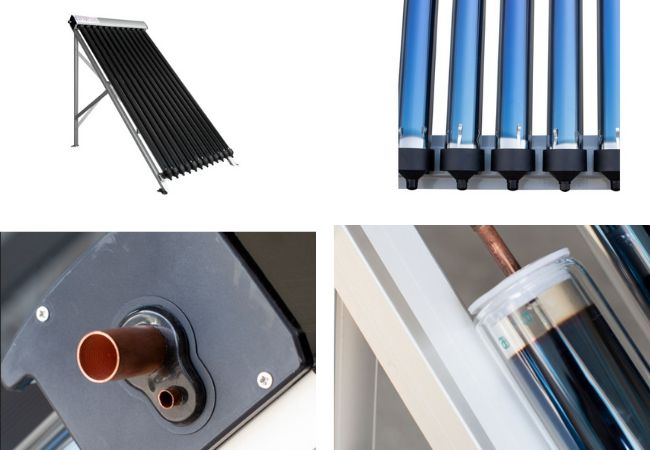
Heat Pipe Collector System
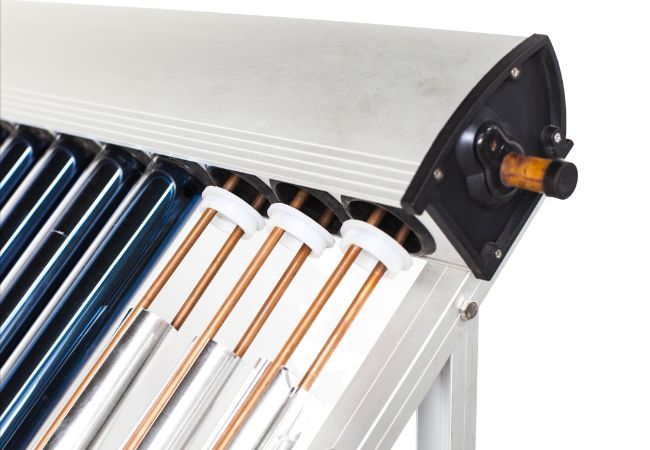
U Pipe Collector System
Solar Powered Water Heater Maintenance
Maintenance is the only sure way of ensuring your system serves you optimally for a long time.
Remember, only certified contractors should conduct the solar water heater repair and maintenance process.
Although these water heating systems are known for nearly zero maintenance, certain practices will ensure this equipment serves you for a long time. The following solar water heater panels maintenance practices increase service lifespan:
- Check the anti-freeze – you can top it up or replace and increase the fluid that has served for a long time.
- Check for possible leakages which may be due to mechanical damage
- Inspect if there are damages to solar heater frames
- Ensure the mountings and valves are working properly
- Remove any possible vegetations or dirt that are on the solar water heating system
- Periodically inspect all parts and components
- Descale the plumbing systems in case you are using hard water
Sizing Solar Systems for Water Heating
Sizing solar thermal water heaters can be the most challenging process. Remember, the solar water heating system should match the practical application requirements.
However, for the scope of this guide, we will focus on some fundamental aspects that can act as your perfect guide.
Solar Collector Size
Collector size will determine the amount of thermal energy the system can generate. Of course, this is an important aspect of the water heating capability.
Applications requiring high water volume will require a larger solar collector. Of course, this should also go hand in hand with the technology.
Water Storage Volume
Even as you consider these two, you should determine the following:
- Fluctuations in temperature – this is critical in areas that experience varying climates (i.e. summer and winter).
- Portability of the solar power water heater
At any given point during the water heating process, there could be two scenarios:
Possibility of Freezing
Your system must have anti-freeze protection. Remember, freezing can damage the solar water heater due to unregulated expansion and contraction.
A mixture of water and propylene glycol transfer fluid solves this problem. However, this is possible with indirect water heater systems.
In case you have a direct water heating system, you may drain the pipes whenever you anticipate freezing.
Alternatively, some systems feature special silicone rubber pipes. These pipes can expand during freezing. This practice is usually referred to as freeze tolerance.
Overheating
In most cases, this is never an issue in the drain backwater heater systems. The pump will stop automatically thereby preventing possible overheating.
In a non-drain back system, there is always the possibility of overheating in case there are no proper precautions.
In some active water heating systems, hot water may continue to circulate within the collector. The net effect is cooling in the solar thermal heat storage tank.
Additionally, pressure relief valves also play a fundamental role in high-pressure systems. At the same time, the low-pressure or vented water heater systems have an open vent. This is an effective safety control.
Apart from these, you must pay attention to any other safety measures during the solar water heater installation. By doing so, you will increase the service lifespan of the solar powered water heater.
Expected Heat Energy
In most cases, the thermal energy will depend on the panel’s efficiency and the sun’s intensity. Therefore, it will vary depending on the weather condition.
Take for example;
- Tropics you should expect 7kWh/m2 every day
- In temperate regions, the average heat energy is about 3.27 kWh/m2 every day
Apart from the weather condition, the technology in the thermal solar panel plays an integral role here.
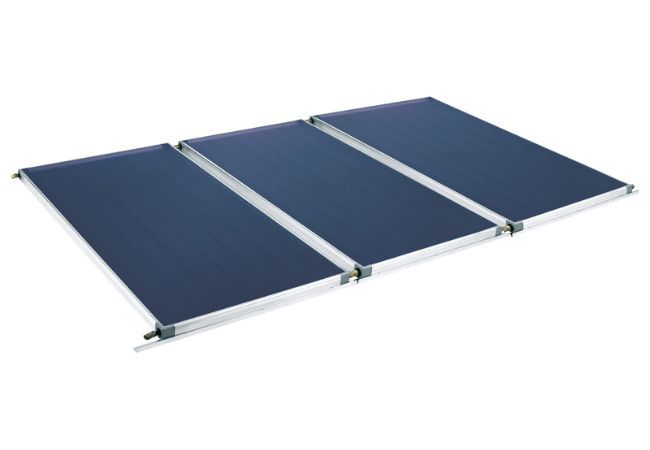
Solar Panels for Water Heaters
Let’s compare the table below courtesy of Wikimedia:
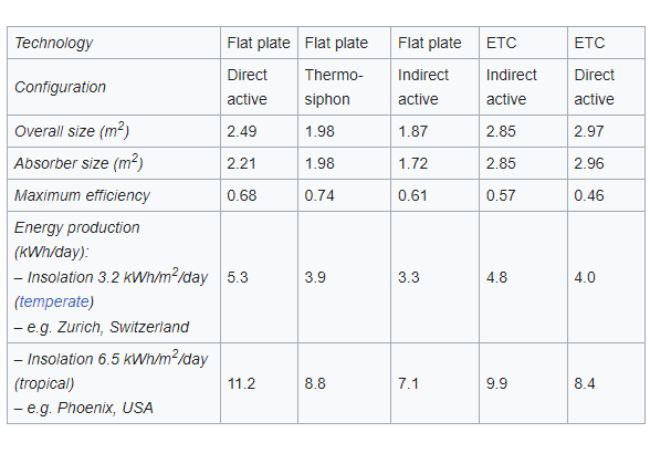
SWH Energy Estimates
Both technology and configurations determine the net thermal energy you can use for your heating systems.
For instance, designing solar water systems for cold weather will be costly. This is due to the complexity of these systems.
The payback period will depend on the design complexity.
Price of Solar-Powered Water Heater
Solar water heater prices depend on the quality, features, and technology.
For example, the prices vary from say 200 USD to over 6000 USD. Therefore, it is quite difficult to estimate the exact price of SWHs.
Simply contact a solar thermal water heating system manufacturer for an accurate quotation.
Of course, they will also help you in the solar panel water heater design process.
Uses of Solar Powered Water Heaters
Ideally, we use solar thermal systems in vary many aspects such as:
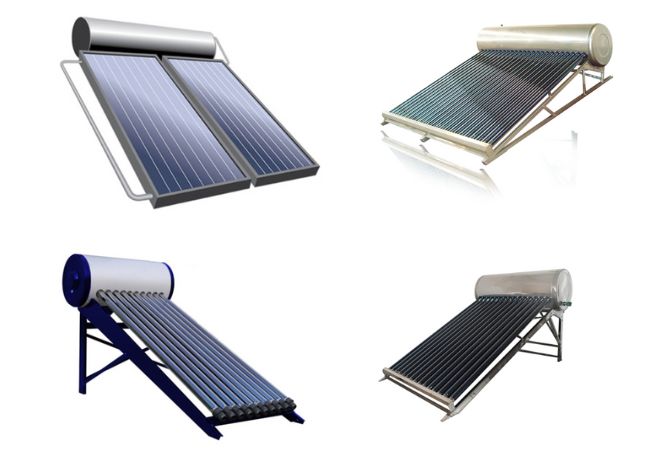
Rooftop Water Heating Systems
- Solar panel water heater for homes – common applications include solar pool water heaters, solar water trough heaters, solar livestock water heaters, solar water heaters for chickens, solar power water heating for bathrooms, etc.
- Commercial solar water heating systems – some common applications include hostels, dormitories, hospitals, or hotels that use the systems to heat water.
- Industrial applications – they play an important role in various preheating processes, cleaning or washing
Even if you intend to use solar water heating systems, it is important to comply with the set rules and regulations. Let’s briefly summarize the main standards for SWH:
| Region | Standards when using SWH |
| Europe |
|
| United States |
|
| Canada |
|
| Australia |
|
Of course, you should also consider the solar panel water heater systems which are ENERGY STAR certified.
Conclusion
Before choosing any solar water heater system, you must specify where you intend to install the equipment and its specific use.
From this information, you will choose the perfect solar thermal heater size and type. For any questions or inquiries, contact us now.
More Resources:
Solar Water Heating System – Source: DOE
Thermal Water Heating System – Source: McCoy Mart
Solar Panel Water Heater – Source: Wikipedia
Type of Water Heaters (SWH) – Source: PENNSTATE
SWH Systems – Source: Britannica
Solar Thermal Water Heater – Source: HAREDA




